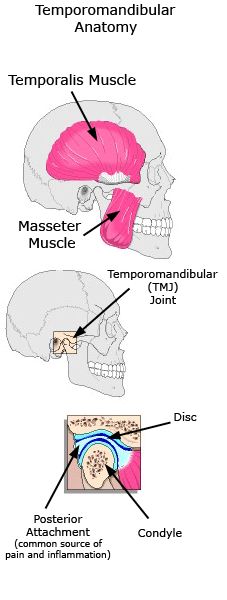Medical Library
Pick a Body Area

Temporomandibular Disorders (TMD)
Temporomandibular disorder (TMD), is a term that describes an entire group of disorders involving the temporomandibular joint or joints (TMJ).
The TMJs are the jaw joints. There is one on each side of your head just in front of your ear canals. Like many other joints in the body, they consist of:
- muscles that control joint movement,
- ligaments that hold the bones together,
- cartilage that provides a smooth surface for the bones to move on,
- a disc that helps with proper movement, of the bones,
- elastic tissue that helps hold the disc in place.
One or more of the above tissues can cause symptoms. In fact, studies suggest that one third of the population at any one time experiences TMJ symptoms such as pain with chewing, yawning, or jaw opening. Women seem to have TMJ problems much more often than men and it is estimated that 3-6% of the population might benefit from treatment.
There are a variety of temporomandibular disorders. The muscles (myogenous), joint(s) (arthrogenous), or a combination of the two may cause pain.
Since physical therapists treat muscle and joint problems, they are ideally suited to address a TMD. Moreover, a majority of patients diagnosed with TMD, also have associated neck pain. Both respond well to treatment provided by a physical therapist. No other healthcare practitioner is better suited to address both the TMD and neck pain.
TMD may appear to be a complex condition and it shouldn't be. This website and your physical therapist can help to insure the following:
- You are properly educated,
- that your treatment is conservative, cost-effective, and reversible,
- goals are realistic,
- your examination is brief and meant to identify your source(s) of pain.
When a physical therapist performs the examination, they will be able to classify you as having one or more of the following:
- An inflammatory condition
- Limited jaw range of motion
- Excessive jaw range of motion
- Arthrogenous Disc Displacement
- Jaw muscle pain
- Neck pain causing related headaches (sometimes mistaken as TMD)
Once the involved structures are identified, the therapist will be able to provide you with the appropriate treatment.
Possible Treatments
Possible Treatment Goals
- Decrease Risk of Reoccurrence
- Improve Function
- Improve Muscle Strength and Power
- Improve Proprioception
- Improve Range of Motion
- Improve Relaxation
- Self-care of Symptoms
- Improve Tolerance for Prolonged Activities
Additional Resources
Disclaimer
The information in this medical library is intended for informational and educational purposes only and in no way should be taken to be the provision or practice of physical therapy, medical, or professional healthcare advice or services. The information should not be considered complete or exhaustive and should not be used for diagnostic or treatment purposes without first consulting with your physical therapist, occupational therapist, physician or other healthcare provider. The owners of this website accept no responsibility for the misuse of information contained within this website.
